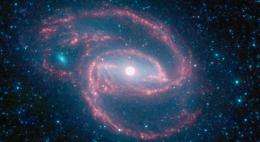NASA's Spitzer Images Out-of-This-World Galaxy

(PhysOrg.com) -- NASA's Spitzer Space Telescope has imaged a wild creature of the dark -- a coiled galaxy with an eye-like object at its center.
The galaxy, called NGC 1097, is located 50 million light-years away. It is spiral-shaped like our Milky Way, with long, spindly arms of stars. The "eye" at the center of the galaxy is actually a monstrous black hole surrounded by a ring of stars. In this color-coded infrared view from Spitzer, the area around the invisible black hole is blue and the ring of stars, white.
The black hole is huge, about 100 million times the mass of our sun, and is feeding off gas and dust along with the occasional unlucky star. Our Milky Way's central black hole is tame by comparison, with a mass of a few million suns.
"The fate of this black hole and others like it is an active area of research," said George Helou, deputy director of NASA's Spitzer Science Center at the California Institute of Technology in Pasadena. "Some theories hold that the black hole might quiet down and eventually enter a more dormant state like our Milky Way black hole."
The ring around the black hole is bursting with new star formation. An inflow of material toward the central bar of the galaxy is causing the ring to light up with new stars.
"The ring itself is a fascinating object worthy of study because it is forming stars at a very high rate," said Kartik Sheth, an astronomer at NASA's Spitzer Science Center. Sheth and Helou are part of a team that made the observations.
In the Spitzer image, infrared light with shorter wavelengths is blue, while longer-wavelength light is red. The galaxy's red spiral arms and the swirling spokes seen between the arms show dust heated by newborn stars. Older populations of stars scattered through the galaxy are blue. The fuzzy blue dot to the left, which appears to fit snuggly between the arms, is a companion galaxy.
"The companion galaxy that looks as if it's playing peek-a-boo through the larger galaxy could have plunged through, poking a hole," said Helou. "But we don't know this for sure. It could also just happen to be aligned with a gap in the arms."
Other dots in the picture are either nearby stars in our galaxy, or distant galaxies.
This image was taken during Spitzer's "cold mission," which lasted more than five-and-a-half years. The telescope ran out of coolant needed to chill its infrared instruments on May 15, 2009. Two of its infrared channels will still work perfectly during the new "warm mission," which is expected to begin in a week or so, once the observatory has been recalibrated and warms to its new temperature of around 30 Kelvin (about minus 406 degrees Fahrenheit).
Provided by JPL/NASA (news : web)
















